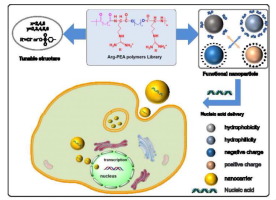Acta Biomaterialia ( IF 9.4 ) Pub Date : 2018-05-25 , DOI: 10.1016/j.actbio.2018.05.040 Xinru You , Zhipeng Gu , Jun Huang , Yang Kang , Chih-Chang Chu , Jun Wu

|
Many different types of polycations have been vigorously studied for nucleic acid delivery, but a systematical investigation of the structure–property relationships of polycations for nucleic acid delivery is still lacking. In this study, a new library of biodegradable and biocompatible arginine-based poly(ester amide) (Arg-PEA) biomaterials was designed and synthesized with a tunable structure for such a comprehensive structure–property research. Nanoparticle (NP) complexes were formed through the electrostatic interactions between the polycationic Arg-PEAs and anionic nucleic acids. The following structure effects of the Arg-PEAs on the transfection efficiency of nucleic acids were investigated: 1) the linker/spacer length (length effect and odd–even effect); 2) salt type of arginine; 3) the side chain; 4) chain stiffness; 5) molecular weight (MW). The data obtained revealed that a slight change in the Arg-PEA structure could finely tune its physicochemical property such as hydrophobicity, and this could subsequently affect the nanoparticle size and zeta potential, which, in turn, regulate the transfection efficiency and silencing outcomes. A further study of the Arg-PEA/CpG oligodeoxynucleotide NP complexes indicated that the polymer structure could precisily regulate the immune response of CpG, thus providing a new potential nano-immunotherapy strategy. The in vitro data have further confirmed that the Arg-PEA NPs showed a satisfactory delivery performance for a variety of nucleic acids. Therefore, the data from the current study provide comprehensive information about the Arg-PEA structure–transfection property relationship; the tunable property of the library of Arg-PEA biomaterials can be one of the promising candidates for nucleic acid delivery and other biomedical applications.
Statement of Significance
Polycations have being intensive utilized for nucleic acid delivery. However, there has not been elucidated about the relationship between polycation’s structure and the physicochemical properties/biological function. In this timely report, an arginine based poly(ester amide) (Arg-PEA) library was prepared with finely tunable structure to systematically investigate the structure-property relationships of polycations for nucleic acid delivery. The results revealed that slight change of Arg-PEA structure could finely tune the physicochemical property (such as hydrophobicity), which subsequently affect the size and zeta potential of Arg-PEA/nucleic acid nanoparticles(NPs), and finally regulate the resulting transfection or silencing outcomes. Further study of Arg-PEA/CpG NPs indicated that the polymer structure could precisely regulate immuno response of CpG, providing new potential nano-immunotherapy strategy. In vitro evaluations confirmed that the NPs showed satisfied delivery performance for a variety types of nucleic acids. Therefore, these studies provide comprehensive information of Arg-PEA structure-property relationship, and the tunable properties of Arg-PEAs make them promising candidates for nucleic acid delivery and other biomedical applications. Overall, we have shown enough significance and novelty in terms of nucleic acid delivery, biomaterials, pharmaceutical science and nanomedicine.
中文翻译:

基于精氨酸的聚(酯酰胺)纳米颗粒平台:从结构-性能关系到核酸输送
对于核酸递送,已经对许多不同类型的聚阳离子进行了严格的研究,但是仍然缺乏对用于阳离子递送的聚阳离子的结构-性质关系的系统研究。在这项研究中,设计并合成了具有可调谐结构的可生物降解且生物相容性的基于精氨酸的聚(酯酰胺)(Arg-PEA)生物材料新库,以进行这种全面的结构-性质研究。纳米粒子(NP)复合物是通过聚阳离子Arg-PEA与阴离子核酸之间的静电相互作用形成的。研究了Arg-PEA对核酸转染效率的以下结构影响:1)接头/间隔区的长度(长度效应和奇偶效应);2)精氨酸的盐类型;3)侧链;4)链条刚度;5)分子量(MW)。获得的数据表明,Arg-PEA结构的细微变化可以很好地调节其物理化学性质,例如疏水性,而这随后可能会影响纳米粒子的大小和zeta电位,进而调节转染效率和沉默结果。对Arg-PEA / CpG寡脱氧核苷酸NP复合物的进一步研究表明,该聚合物结构可以精确地调节CpG的免疫反应,从而提供了一种新的潜在的纳米免疫治疗策略。这 对Arg-PEA / CpG寡脱氧核苷酸NP复合物的进一步研究表明,该聚合物结构可以精确地调节CpG的免疫反应,从而提供了一种新的潜在的纳米免疫治疗策略。这 对Arg-PEA / CpG寡脱氧核苷酸NP复合物的进一步研究表明,该聚合物结构可以精确地调节CpG的免疫反应,从而提供了一种新的潜在的纳米免疫治疗策略。这体外数据进一步证实,Arg-PEA NPs对多种核酸均表现出令人满意的递送性能。因此,本研究的数据提供了有关Arg-PEA结构与转染特性关系的全面信息。Arg-PEA生物材料文库的可调性可能是核酸递送和其他生物医学应用的有希望的候选者之一。
重要声明
聚阳离子已被广泛用于核酸递送。然而,尚未阐明聚阳离子的结构与理化性质/生物学功能之间的关系。在这份及时的报告中,制备了具有精调结构的基于精氨酸的聚(酯酰胺)(Arg-PEA)文库,以系统地研究用于阳离子递送的聚阳离子的结构-性质关系。结果表明,Arg-PEA结构的细微变化可以微调其理化性质(例如疏水性),随后影响Arg-PEA /核酸纳米颗粒(NPs)的大小和Zeta电位,并最终调节所得的转染或沉默结果。体外评估证实,NP对各种类型的核酸均显示出令人满意的传递性能。因此,这些研究提供了Arg-PEA结构-性质关系的全面信息,并且Arg-PEA的可调节特性使其成为核酸输送和其他生物医学应用的有希望的候选者。总体而言,我们在核酸递送,生物材料,药物科学和纳米医学方面已显示出足够的意义和新颖性。











































 京公网安备 11010802027423号
京公网安备 11010802027423号